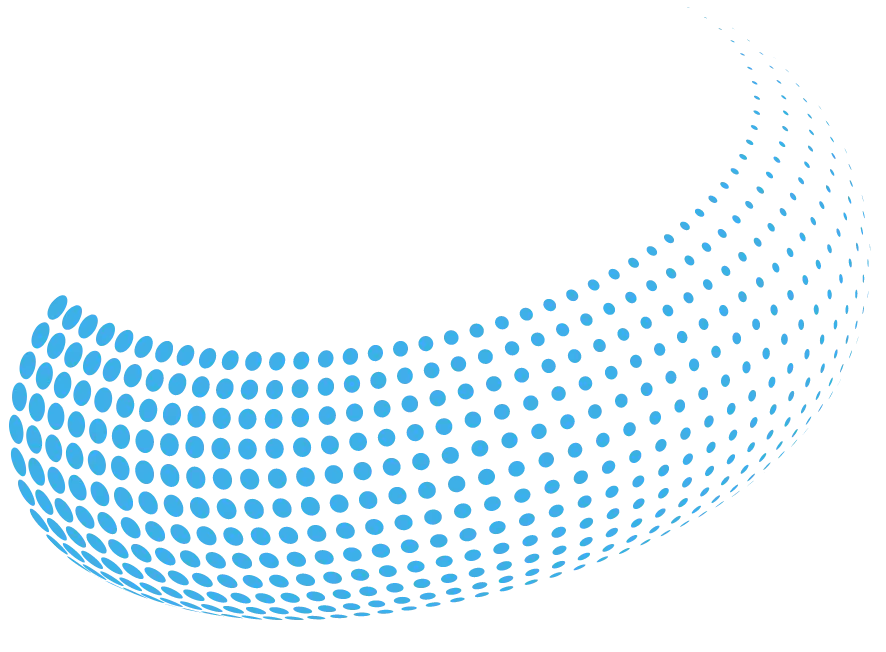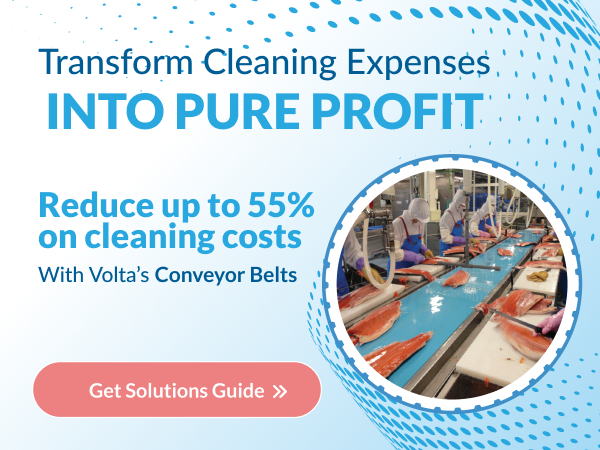Home » FAQ
How can we help you?


We recommend filling out our questionnaire and sending to our technical service team. We will guide you through the selection process to a working solution.
We are happy to send samples for evaluation – using the support page, please contact us with your requirement.
Volta works with many dedicated conveyor builders and OEMs – we will be happy to put you in touch with a reliable one in your area.
we have a list which details the resistance of our different TPE types to a wide variety of chemicals. The information can be found in the files via your customer log in. If you do not have access to our customer login, please write for details on our support page.
Basically, Volta has solutions for direct contact with all food types. Our belts are selected based on mechanical specifications, the environmental conditions, texture, consistency and load of the foodstuff as well as desired through-put. There are cases, such as acidic food where the choice will be influenced by chemical composition and content. We have many great belt choices for these applications as well.
The new RoundFlex™ lace is designed to bend in a true arc around the conveyor pulleys. Most similar systems in the market do not. They move around the pulley with uneven geometry as the two lace edges are forced upwards and bend into a sharp angle. Volta RoundFlex™ lace prevents this and thus ensures a longer-lasting lace with less chance of food trapped under the belt as well as enabling a correctly aligned, cleanable surface where a scraper is used.
In short, Li is “inner length”, La is “outer length and Lp or Lw is “pitch or working length”. Roughly, La = Li plus twice the belt thickness multiplied by Π (pi). The Lp is a dimension that is halfway between La and Li. For thicker belts including profiles, it is critical to specify how the belt was measured and a mistake can be the difference between a belt working and not working. We recommend measuring carefully when the belt is not under tension. To measure on a simple 2 axle conveyor, position the tensioner so the shafts are as close together as possible and add half the circumference of both pulleys (D *Π)/2.
Volta TPE materials divide, broadly speaking into three categories for the purpose of welding, both for hand welding and HF. Our very hard H, K belt, and W guide, materials form a separate category and are compatible one with another. Most other materials can be welded one to another although LT is easier to weld onto other LT material.
Volta offers a variety of wear resistant coating materials that are commonly welded onto V profiles and timing belts. There are various types of grip texture and foam coatings available. The uses are many and vary: stop/start operations, conveying fragile materials like glass and china, gripping thin plastic wrap or transporting bundles of insulation up a gradual incline. The heat fusion we use ensures that the texture does not detach from the belt.
1: Volta has a welding guide available on this site or by using the enquiry form. This details how to use our welding systems: FBW,PDW, FT, profile welders and hand pliers.
2: If a section of belt needs to be replaced with a ‘Dutchman’, the length of the insert should be long enough so that the two welds are not positioned on the pulleys concurrently.
1: Cleaning is the responsibility of the plant and the QS department is empowered to design a cleaning protocol that must be effective without damaging the belts.
2: Volta can save over 50% in water consumption, wash down time and work hours cleaning and maintaining the belt compared to a modular belt. Significant savings are also achieved when replacing fabric based plied belt.
3: If a factory changes over to a Volta belt and does not reassess its cleaning protocol, the full saving will not be realized, and damage can be done to the belt by over use of chemicals
4: Other belt types require higher concentrations of chemicals to clean effectively but this exposure to harsh chemicals also degrades the belts, creating more areas for bacteria growth. Damage of the belts can also result from leaving cleaning chemicals on the belt for too long before washing with water.
5: When changing to Volta, old habits need to be evaluated. New correct cleaning protocol needs to be reassessed, validated, and documented.
6: Belt manufacturers do not dictate the protocol as there are thousands of different foods in different stages of production – ‘this is the duty of the user‘. Each center has its own criteria.
7: Additional information appears in the technical manual. Any locking system must ensure that sprockets and pulleys do not float from side to side.
8: If a hot wash is required, Volta material can be washed with hot water while the conveyor is standing still and it should not be switched on until the belt cools.
1: Thermoplastic belts contain several times more plastic than a fabric based plied belt of the same thickness. The production process is also far slower in order to ensure the density and uniformity of the material.
2: All in all, the prices should be comparable with top quality modular belts. Any differences can be explained by local price competition. Critically, it is
3: a tested and provable fact that thermoplastic belting yields a better return on the money invested for food contact applications when compared to any other plastic belt type.
1 : For new conveyor systems, SuperDrive™ and Mini SuperDrive™ will solve off-tracking and slipping problems making them the best choice. Their ability to trough easily, the large range of textures, thicknesses and materials allows them to out-perform most other belts types in numerous applications. DualDrive™ can give extra rigidity across the belt in very specific circumstances. Contact us for advice.
2 : When retrofitting an existing conveyor that uses 1″ or 2″ pitch sprockets, Mini DualDrive™ and DualDrive™ might be an easier option to install. This is definitely the case on a conveyor fitted with a drum motor with moulded 1″ or 2″ pitch teeth. In some cases, it depends on the sprocket size used and the construction of the belt support or carry way design. The complexity of the bed modification will depend on the design or construction of the carry-way. When the slide bed is a herringbone pattern, DualDrive™ is almost always preferred. A belt under 250mm in width is better suited for DualDrive™ and the belt can run if only supported on both edges, like a modular belt. If tracking is critical, SuperDrive™ may still be an option and our technical team will give clear accurate advice on your possibilities.
Volta flat belts can replace most friction driven belts. There is no equivalency chart to look up a Volta version of a plied belt as the technology we offer is radically different. We prefer to advise first time users on belt selection. Thick friction-driven belts can often be replaced with a more effective, thinner Volta belt type. We also have an instructive flyer that explains the do’s and don’ts of changing over.
Fabric-based plied belts are commonly joined with a vulcanized finger splice. The thin, porous plastic in these belts is not enough to weld the edges together and the finger pattern increases the contact surface between the two belt edges. Pressure is applied to melt the plastic and bond the interlocking fingers together. Cutting and vulcanizing are time-consuming and awkward to do on site and the resulting joint is weak and prone to rubbing and delamination. Due to the weak joint, many ply belts fail long before the belt is worn. In many cases, the belt strength expected from the data sheet is not achieved as the belt is only as good as the splice. On small diameter pulleys, the finger points are subject to extreme stress which causes them to fail quickly.
Homogeneous, non-reinforced Volta belts do not absorb or harbor humid residue like other belt types. A special hydrolysis resistant belt material is offered for environments where high chemical degradation is suspected. Volta Positive Drive options also solve the issue of slippage on rollers which is a problem that plagues fabric belts, especially in wet applications. Custom-made perforations are available to suit most drainage requirements.
Volta belts have no links or joints. The solid surface eliminates leakage through the belt and the reduced water and wash down time required at clean-up significantly decreases the presence of liquid in and around the conveyor system, enhancing the health and safety of the employees as well as providing a hygienic processing platform.
Volta haul offs and caterpillar belts are made from welded layers of TPE. We produce wide range of coatings including foamed PU for impact resistance. One customer installed these on an application where belt lifetime was previously measured in hours. Volta’s welded versions have given them months of trouble-free performance.
The belt you are using is far stronger than the application requires but the belt cannot withstand the cutting and scratching actions of the steel parts it conveys that destroy the plastic top surface and dig into the belt fibre layers as well as destroying the belt joint. We have many installations in automotive and steel industries that give 4 to 5 times the belt lifetime of thick, strong, fabric based plied belts.
We have no defined upper limit but our flat belts work on optical sorters at 5 metres/second and our positive drive belts are working at over 2 metres/second. Please note that at high speeds, a larger pulley diameter is required than the recommended minimum.
The correct way of rating our belts is by checking the ‘belt temperature‘, not the product temperature. We use a coefficient formula for each belt type at various temperatures. That calculates the true required belt strength for an application which gives a fair prediction of suitability. We have belts that can take a given load at 90° C (194° F). Consult with us for more information.
You can do this yourself using the Volta cost saving calculator. Just feed in the relevant data. Please note that this only shows some quantifiable savings and does not include the savings of replacing belt parts or the improved hygiene and reduced risk of contaminated product.
Volta has developed a calculation based on ‘pull force’ that confirms the belt capabilities by taking the expected load, friction, and belt temperature criteria into account. We see from experience that many plied belt types are very strong on paper but fail to perform mechanically – belt strength alone is a misleading indication of belt life and performance.
1 : Volta positive drive belts are designed to work without pretension. If a load is heavy enough, or an incline steep enough, it is recommended to use some pretension to ensure correct engagement with the sprockets. It is sometimes difficult to assess this need in advance but as a rule of thumb, if the required ‘pull force’ of an application is calculated to be over one third of the belt’s available pull force, Volta will recommend pretension.
2 : The best practise is to install a tensioning device and use a very small amount of pretension. The maximum permitted is 0.5%. Mini DualDrive™ and Mini SuperDrive™ with a width over 700mm should always have some pretension as should trough conveyors.
1 : A tension system has two functions. It simplifies mounting the belt and welding on site and it assists with sprocket engagement, especially where elongation is expected due to a heavy and/or hot product.
2 : A quick release tensioner, which is fitted on a cantilevered pulley, makes cleaning easy and helps where a belt is removed and
3 : replaced by preserving the initial pretension setting and belt length. A tensioner should be long enough to allow for the belt to achieve 0.5% pretension. It is also useful in cases of repair. The minimum length shortened in a repair is 2 tooth pitches ( 80mm). As a rule of thumb, 300mm or about 12 inches of take-up is recommended .
1 : To measure a SuperDrive™ belt, one needs to remember that 2 teeth (approximately 80mm) will need to be cut out for any corrections in belt length or repairs.
2 : The procedure for measuring a classic flat belt length on a 2 axle conveyor is to position the shafts as close together as possible and then add half the circumference of the drive pulley and half that of the tail pulley.
3 : For SuperDrive™, position the tensioner so that it is extended out about three quarters of its maximum position for measuring the axle-to-axle dimension.
1 : We recommend not incorporating catenary sag in the belt path. The belt should follow the pulleys and should, ideally, wrap 180 degrees around the drive and tail. Provision for sag can be made if there is an expectation of significant elongation from heat and load by leaving a suitable gap on the return path that does not cause early disengagement from the drive sprocket. Drive snubbing options available.
2 : VOLTA recommends that the belt be snugged to the drive and tail pulleys to ensure maximum efficiency of the design.
1 : A 2″modular belt can be replaced most easily with Volta DualDrive™. We have a retrofit manual to explain how this is done. If there are concerns about off-tracking, SuperDrive ™can be an option but the slide bed/carry way will need adjusting by accommodating the belt drive tooth profile between two wear strips. In addition, as the SuperDrive™ belt pitch is not 2″, the height of the slide bed/carry way may need adjusting.
2 : For 1″ pitch belts, Volta has two options, Mini DualDrive™ and Mini SuperDrive™. Again, the self-tracking option of Mini SuperDrive™ will need the slide bed/carry way to be adjusted to contain the row/s of teeth.
3 : For further details, please contact us for a clear assessment of the options and our assistance in achieving your hygienic upgrade.
1 : Drive sprockets, tail and support pulleys need to be locked in place. Volta supplies ‘locking collars’ for standard 40mm square axles.
2 : Some additional information appears in the technical manual. Any locking system must ensure that sprockets and pulleys do not float from side to side.
1 : The position depends on belt width and the conveyor construction. There should be no depression between the drive or tail on the given axle and the supports on either side of the drive or tail.
2 : A midway position can be used as a rule of thumb. If a depression appears, the support can be moved closer to the drive or tail but not closer than 100mm. A design guide for the load bearing capacity of our belts with various arrangements of support pulleys, can be found in the technical manual.

